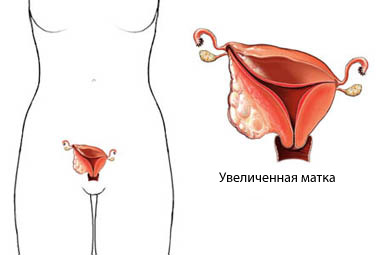Uterine cancer – Endometrial cancer
Description of endometrial cancer
Uterine cancer – disease, in which cancer cells grow in the uterus.
The lower part of the uterus, which is closer to the vagina, It called the cervix. If the cancer develops this part, it is called cervical cancer.
The walls of the uterus (excluding cervix) It consists of endometrial (the inner shell) and myometrium (the outer muscular coat). The most common type of uterine cancer is called adenocarcinoma, and occurs in the endometrium. A less common type of cancer, called Kaposi, It arises in the myometrium. This article describes endometrial cancer.
Cancer occurs, when the body's cells divide uncontrollably and form a build-up (weight) of cloth, called a growth or tumor. The term cancer refers to malignant tumors, that can invade nearby tissues and spread to other parts of the body. Benign tumors do not spread to other organs.

Causes of endometrial cancer
The causes of endometrial cancer is unknown.
Risk factors for endometrial cancer
Factors, which increase the risk of endometrial cancer:
- Age: 50-60 years;
- Obesity (especially in women with early menopause, aged 45 years);
- High blood pressure;
- Polycystic ovary syndrome;
- Endometrial Polyps;
- Infertility;
- Early onset of menstruation;
- Late menopause (strong effects of estrogen);
- Diabetes;
- Environment: Life in the city.
Symptoms of endometrial cancer
These symptoms, except for uterine cancer, They may be caused by other, less serious diseases. If you experience any of them, consult a doctor.
- Abnormal bleeding between periods;
- Vaginal bleeding or spotting in postmenopausal women;
- Pain in the pelvic area;
- Pain with urination;
- Pain during sexual intercourse.
Diagnosis of endometrial cancer
The doctor will ask about your symptoms and medical history, and perform a physical examination.
Tests may include:
- Blood and urine tests;
- Examination of the vagina, uterus, ovary, bladder and rectum;
- Mazok Papanicolaou – scraping and testing tissue from the vagina, cervix;
- A biopsy of the mucous membrane of the uterus – removal of a sample of tissue from the uterus for testing;
- Dilation and curettage of the uterus – procedure, performed to a sample of tissue from the uterus.
Treatment of endometrial cancer
After the discovery of uterine cancer examination is conducted, allowing to determine the extent and scope of cancer. Methods of treatment depends on the stage of the disease.
Treatment includes:
Surgery for cancer of the uterus
It may be formed hysterectomy, to remove the uterus, the fallopian tubes, ovary, and, perhaps, nearby lymph nodes.
Radiation therapy for cancer of the uterus
Radiation therapy uses radiation emissions, to kill cancer cells and shrink tumors. Radiation therapy may be of the following types:
- External radiation therapy – radiation is directed at the tumor from a radiation source outside the body;
- Internal radiation therapy – radioactive materials placed in the body near cancer cells.
Gormonalynaya therapy
To reduce the spread of cancer cells outside the uterus can be used drugs. The method used, if you can not do the surgery, for women, who have a recurrence of cancer, or cancer, which has spread to other organs (Metastasis).
Chemotherapy for cancer of the uterus
Chemotherapy – the use of drugs to kill cancer cells. Preparations for the chemotherapy may be given in various forms: tablets, injection, the introduction of a catheter. The drugs enter the bloodstream and spread throughout the body, killing mostly cancer, and also some healthy cells. Chemotherapy has delimited application in the treatment of endometrial cancer.
Prevention of endometrial cancer
All women should have a yearly pelvic exam, to keep track of any changes, that may signal the presence of cancer. Use of oral contraceptives also help protect against cervical cancer.
